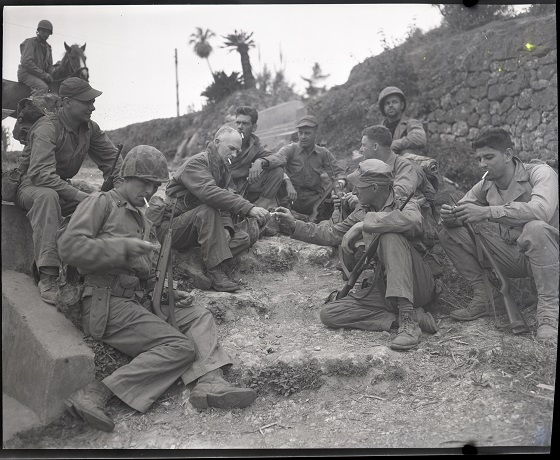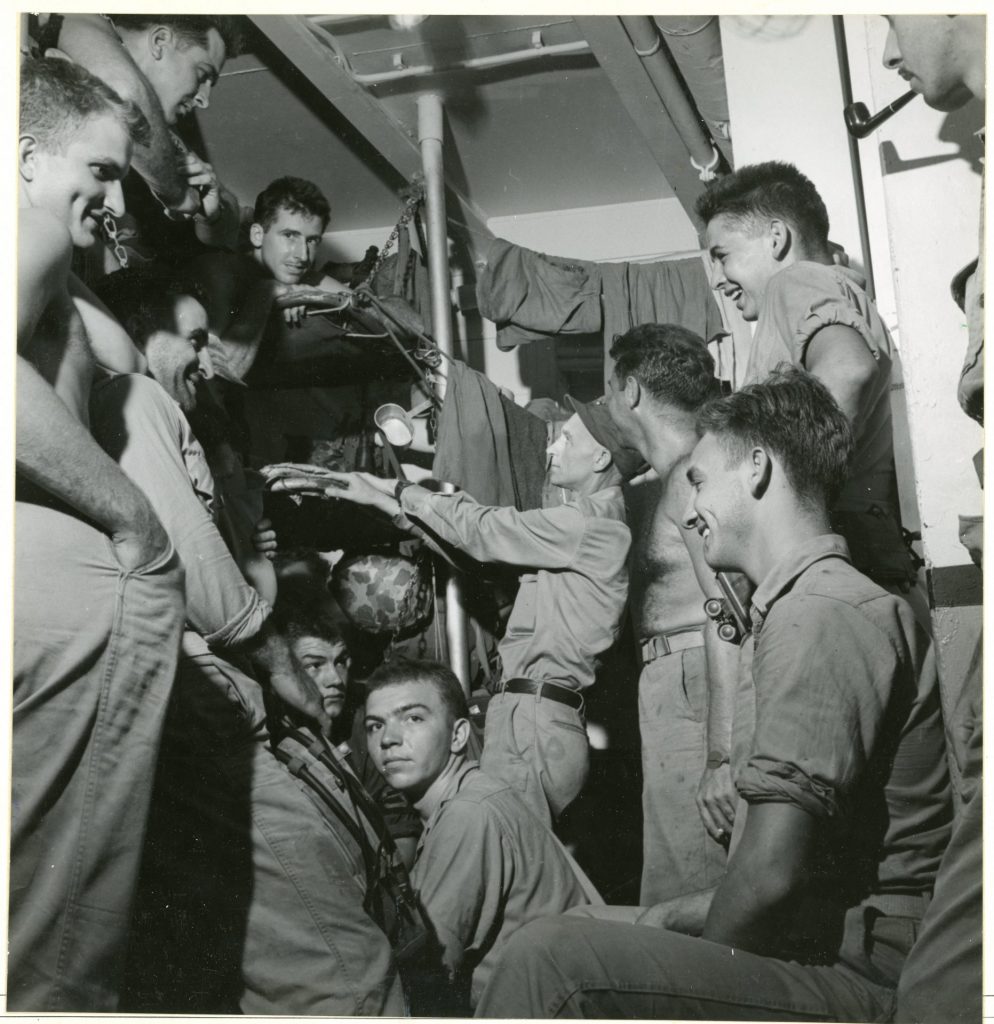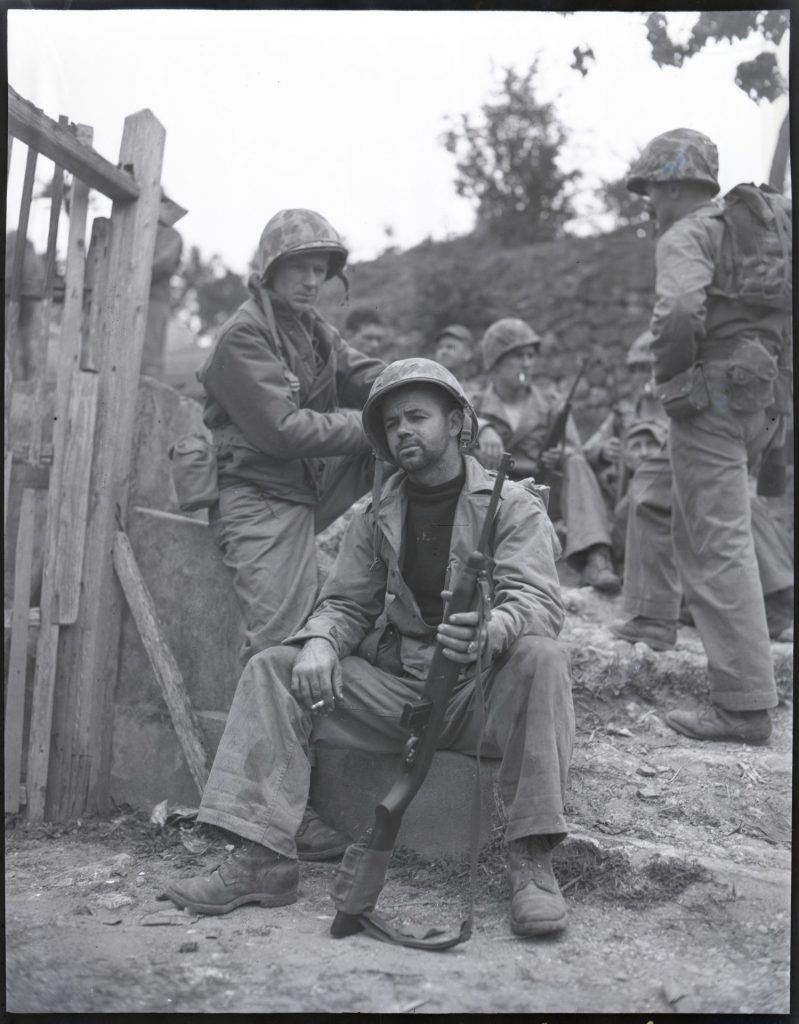
Plan your visit
The Last Assignment: Ernie Pyle on Okinawa
August 3, 2020

In early April 1945, while covering the American invasion of Okinawa, an island located only 330 miles from Japan, two war correspondents, one a veteran of the Pacific War and the other a newcomer to the theater, were busy writing stories about the battle in a room aboard the USS Panamint, a McKinley-class command ship that served as the flagship of Rear Admiral Lawrence F. Reifsnider.
As the clacking of their typewriter keys slackened, the two men — Time magazine’s Robert Sherrod and Scripps-Howard News Service columnist Ernie Pyle, who both had been firsthand observers of fighting during the war, discussed how they had grown tired of the grind of combat and were looking forward to going home. In fact, Sherrod planned to leave for the United States in a couple of days. “I’m getting too old to stay in combat with these kids,” Pyle told Sherrod, “and I’m going to go home, too, in about a month. I think I’ll stay back around the airfields with the Seabees and engineers in the meantime and write some stories about them.” (Pyle had written a U.S. Navy public relations officer he knew that he had a “spooky feeling that I’ve been spared once more and that it would be asking for it to tempt Fate again.”)
As Sherrod prepared to leave the Panamint, he could not find the ship’s mess treasurer, to whom he owed $2.50 for two days’ meals. Pyle agreed to pay the bill for his colleague, and asked Sherrod to see about forwarding his mail when he made it to the American base on Guam. From there, Sherrod began his long voyage home, traveling to Pearl Harbor, San Francisco, and finally New York.

Ernie Pyle visiting with Marines aboard USS Charles Carroll (APA-28) while en-route to Okinawa / Date: March 20, 1945; U.S. National Archives
The encounter on the Panamint marked the last time Sherrod saw Pyle alive, as the Time correspondent left Okinawa on April 11. While in Hawaii, Sherrod heard the news of Pyle’s death from Japanese gunfire on April 18 while on a mission with the U.S. Army’s Seventy-Seventh Infantry Division. “I never learned which doughboy of the Seventy-Seventh Division persuaded Ernie to change his mind and go on the Ie Shima invasion off the west coast of Okinawa,” said Sherrod. “But Ernie rarely refused a request from a doughboy, or any other friend.”
Pyle, who had become famous for his syndicated newspaper columns focusing on the average infantrymen in North Africa, Sicily, Italy and France, had reluctantly agreed to report on the war in the Pacific, telling his readers he was going “simply because there’s a war on and I’m part of it and I’ve known all the time I was going back. I’m going simply because I’ve got to go, and I hate it.”
Arriving in the new theater of operations, he compared it to learning how to live in a new city. “The methods of war, the attitude toward it, the homesickness, the distances, the climate—everything is different from what we have known in the European war.”
After spending three weeks with the crew of a small aircraft carrier, the USS Cabot, and battling with U.S. Navy censors about his reporting (he won the fight), Pyle debated whether he should accompany the U.S. Marines for the invasion of Okinawa. He believed he would be killed if he went in with the troops for the landings, but decided to go. “I think I’ll come through it after all,” he wrote his friend and editor Lee Miller.

PFC. Urban Vachon of Laconia, NH, and Columnist Ernie Pyle, rest by the roadside on the trail at Okinawa / Photographer: Barnett / Date: April 8, 1945; U.S. National Archives
Pyle’s coverage of the last battle in the Pacific war began with a sober final intelligence briefing on the Panamint berthed in the Ulithi atoll, after which “nobody could have felt overconfident,” noted Sherrod. After hearing from invasion planners that the Okinawa landings were expected to be “horrendous—worse than Iwo,” according to Sherrod, Pyle said to him, “‘What I need now is a great big drink.’ We did have a drink. Many of them.”
Ulithi’s jovial commander, Commodore Oliver Owen “Scrappy” Kessing, had arranged a farewell party at the officers’ club (the Black Widow) on Asor Island for the correspondents and high-ranking officers from the navy and First and Sixth Marine Divisions. The party included a band and, “miraculously,” women—about seventy nurses from the six hospital ships in the anchorage, plus two women radio operators from a Norwegian ship. “Everybody got drunk . . . as people always do the last night ashore,” Sherrod recalled, noting that Pyle had been “the lion of the party.”
The next morning, as the approximately forty reporters and photographers left Asor for their assigned ships, Kessing had an African American band on the dock playing its own “boogie-woogie” version of sad farewell music. Also on hand to see them off was a Seabee lieutenant whose detachment had built most of the base and a special guest, Coast Guard Commander Jack Dempsey, the former boxing champion. Someone in the crowd on the dock shouted out a warning to Pyle to be sure to keep his head down on Okinawa. “Listen, you bastards,” Pyle joked to his colleagues, “I’ll take a drink over every one of your graves.” Then, he turned to Dempsey, who, Sherrod noted, weighed about twice as much as the rail-thin reporter, put up his fists in mock belligerence, and asked the former boxer, “Want to fight?”
On his way to Okinawa onboard the USS Charles Carroll, a Crescent City-class attack transport, Pyle prepared for the ordeal ahead of him by getting as much sleep as he could in a cabin he shared with Major Reed Taylor, a veteran of the fighting on Guadalcanal earlier in the war. Between his naps, Pyle tried to catch up on his reading and listened to the latest war news broadcast once or twice a day over the ship’s loudspeakers. “Every little bit of good news cheers us,” he noted. “The ship, of course, is full of rumors, good and bad, but nobody believes any of them.” Before sailing, Pyle had been able to add a note to a letter to his wife, Jerry, that read: “Because of censorship I can’t tell you where I am, or why, or what happens. They are waiting for me so I must go now. I hate it that this letter is so short, so inadequate. I love you and you are the only thing I live for.”
On the morning of the invasion, April 1, 1945, Pyle enjoyed a ham-and-egg breakfast before stepping onto a landing craft for his trip to shore with the Fifth Marine Regiment. He and other correspondents were set to land about a hour and a half after the American forces hit the beach. “There’s nothing romantic whatever in knowing that an hour from now you may be dead,” Pyle wrote. He also dreaded what he might find on the beach—the mangled bodies of wounded and dead marines he had come to know well on the voyage.
Both Pyle and the marines were stunned, and delighted, to discover there had been very few casualties; the landings had been unopposed by the Japanese. One of the relieved marines wished he could “wear Ernie Pyle around his neck as a good-luck charm” for the rest of the war. The beach was quiet enough for Pyle to enjoy a picnic meal of turkey wings, bread, oranges, and apples. “You can’t know the relief I felt,” he wrote Jerry, “for as you know I had dreaded this one terribly. Now it is behind me, and I will never make another landing, so I can’t help but feel good about that.”
The ease of the initial landings gave way to much tougher fighting as American forces made their way inland. The main Japanese force had withdrawn to the southern portion of the island, where they hid their artillery and heavy weapons in caves and dugouts, protecting them from attacks form the air and from the U.S. ships offshore. Pyle spent two days with the marines before returning to his transport to write. He rejoined the Fifth Marines and was on hand when they captured some frightened enemy soldiers. “Fortunately they happened to be the surrendering kind, rather than [the] fight-to-death kind, or they could have killed several of us,” he wrote his wife about the experience.
Returning to the Panamint, Pyle learned about a new mission involving the Seventy-Seventh Infantry Division, tasked with capturing Ie Shima, a ten-mile-square island located west of Okinawa and home to three Japanese airfields. The operation was set for April 16. Pyle agreed to go with the soldiers for the fight, but only after the initial landing had been made. “I’ve got almost a spooky feeling that I’ve been spared once more and that it would be asking for it to tempt fate again,” he wrote Miller. “So I’m going to keep my promise to you and to myself that that [Okinawa] was the last one. I’ll be on operations in the future, of course, but not on any more landings.” Pyle worked on a draft of a column he intended to release when victory was achieved in Europe.
The Seventy-Seventh met with stiff resistance from the Japanese on Ie Shima when it hit the beach on April 16 — a landing Pyle observed from the Panamint. The next day, Pyle and other correspondents boarded a landing craft for the trip to the small island’s beach. After landing, Pyle went to the command post of the division’s 305th Regiment. As he talked to the soldiers and their officers, he saw one GI killed by a Japanese mine. “I wish I was in Albuquerque!” he exclaimed, remembering his home there. He spent the night on Ie Shima, sleeping in a former Japanese dugout.
At about ten o’clock the next morning, Pyle climbed into a jeep with Lieutenant Colonel Joseph B. Coolidge, the 305th’s commanding officer. Coolidge and three other soldiers hoped to find a site for a new command post for the regiment. Joining Pyle and Coolidge on the trip were Major George H. Pratt and two enlisted men, Dale W. Bassett and John L. Barnes. The group traveled down a narrow road that had been cleared of mines and was thought to be safe. “We followed some 2½ ton trucks and every indication pointed to a fairly calm trip except for occasional mortars dropping into the open fields on either hand, where two infantry division battalions had dug in for the night. The men were finishing breakfast and preparing to move forward to new positions.”
At the jeep slowed to avoid traffic ahead near the village of Ie, a Japanese soldier hidden in a coral ridge about a third of a mile away fired on the vehicle with his Nambu machine gun. “All of us without a second thought jumped for safety into the ditch on either side of the road,” Coolidge remembered. Pyle, Bassett, and Coolidge dove into a ditch on the right-hand side of the road, while Barnes went to the left and Pratt crouched further ahead in a ditch near a small farm road. Both Coolidge and Pyle raised their heads to see if the others had been hit by the enemy’s fire. Seeing Pratt, Pyle asked, “Are you all right?” The Japanese soldier fired again. After ducking the bullets, Coolidge turned to see Pyle lying on the ground. “He was lying face up, and at the time no blood showed, so for a second I could not tell what was wrong,” Coolidge noted. A bullet had struck Pyle’s left temple—America’s favorite war correspondent was dead.

This photo provided by Richard Strasser, perhaps never before published, shows famed World War II war correspondent Ernie Pyle shortly after he was killed by a Japanese machine gun bullet on the island of Ie Shima on April 18, 1945. The Army photographer who crawled forward under fire to make this picture later said it was withheld by military officials. An AP survey of history museums and archives found only a few copies in existence, and no trace of the original negative. (AP Photo/Courtesy of Richard Strasser); Indiana Historical Society ** NO SALES **
After recovering Pyle’s body, soldiers built a coffin for their friend and buried him along with the others killed on Ie Shima. About two hundred men from all ranks and representing all parts of the armed forces attended the burial service held on April 20, which lasted about 10 minutes. “With the exception of an occasional blast of distant guns and the murmuring of the waves 100 yards away, all was quiet,” recalled Nathaniel B. Saucier, the 305th’s chaplain.
Edwin Waltz, Pyle’s personal secretary at Pacific Fleet headquarters, went through the correspondent’s personal effects and discovered the handwritten draft of his column about the end of the war in Europe. “My heart is still in Europe, and that’s why I’m writing this column,” Pyle noted. “It is to the boys who were my friends for so long.” His only regret of the war was that he was not with them when final victory had been won against the Germans. The column, which was never published, reveals as does no other piece of writing the terrible personal toll the conflict took on him. Pyle wrote that buried in his brain forever would be the sight of cold, dead men scattered everywhere: “Dead men in such monstrous infinity that you come almost to hate them.” For the reader at home, Pyle wrote, these men were merely “columns of figures, or he is a near one who went away and didn’t come back. You didn’t see him lying so grotesque and pasty beside the gravel road in France.” Pyle and his colleagues, however, saw them, and they saw them by the uncountable thousands: “That’s the difference.”









